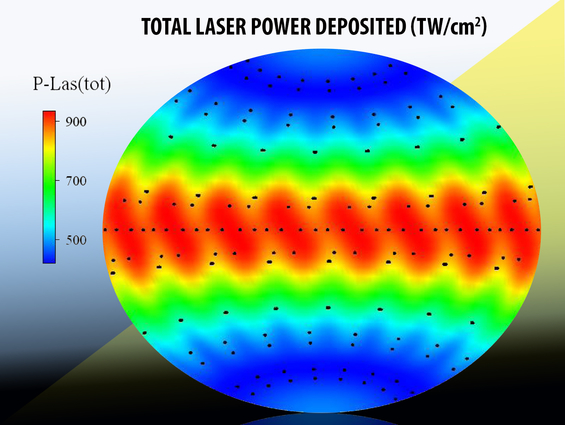Scientists use simulations to examine the performance of materials in NIF experiments
 (Download Image)
(Download Image)
This images show computed laser power per unit area on the capsule surface used in the experiments. The black dots indicate the pointing on the capsule surface.
Scientists have examined the performance of pure boron, boron carbide, high-density carbon and boron nitride ablators — the material that surrounds a fusion fuel and couples with the laser or hohlraum radiation in an experiment — in the polar direct drive exploding pusher (PDXP) platform, which is used at the National Ignition Facility (NIF). The platform uses the polar direct drive configuration to drive high ion temperatures in a room-temperature capsule and has potential applications for plasma physics studies and as a neutron source.
The key findings of the work, featured in High Energy Density Physics, show that these alternate ablators do not improve the symmetry of the PDXP implosion, according to lead author Heather Whitley, associate program director for High Energy Density Science in the Fundamental Weapon Physics section at Lawrence Livermore National Laboratory (LLNL).
“While our simulations predict that the platform is not amenable to the electron-ion coupling measurements due to a lack of implosion symmetry, the alternate materials do enable better coupling between the laser and capsule,” she said. “We plan to test those predicted impacts on future neutron source experiments.”
LLNL’s Neutron Source Working Group is examining the improvement in coupling because it could help improve the yield of the polar direct drive neutron sources, and ultimately provide data on the validity of laser modeling for direct drive simulations.
Through the course of this work, the team also helped inertial confinement fusion simulation code developers implement more advanced models for electron-ion coupling, and modeling the direct drive implosions has been closely coupled with that code development.
NIF provides access to data in extremely hot plasmas that help validate and improve radiation-hydrodynamic modeling for a variety of Lab and astrophysical systems. One of the main goals of NIF has been to create ignition in a deuterium-tritium plasma in the laboratory, but successfully designing experiments to achieve that goal has been a challenge. The design of these experiments relies heavily on computer models that are based on an understanding and assumptions about the behavior of these hot plasmas.
As a postdoctoral appointee, Whitley worked on the Cimarron Project, a Laboratory Directed Research and Development project that was aimed at using high performance computing to study the physics of ignition plasmas.
“The goal of Cimarron was to develop new models that described heat and mass transport at a microscopic level in order help improve our modeling of ignition experiments,” she said. “Following the work on computer models, we wanted to test our new models with experimental data and developed the PDXP platform as a way of creating a non-equilibrium plasma.”
In these experiments, ions are heated more rapidly than the electrons via a very strong laser-generated shock. The team intended to use time resolved spectroscopy, which is a measure of how much light is being emitted from the plasma at a specific frequency, in order to measure the temperatures of both the ions and the electrons as a function of time during the experiment. The data would enable the team to make a direct comparison to the models the Cimarron Project had developed for something called “electron-ion coupling,” which is a parameter that describes how ions and electrons exchange energy in a plasma.
Experiments test how materials perform at NIF
“The PDXP platform was developed at NIF to study electron-ion equilibration but ended up being an ideal neutron source for several other campaigns,” said Marilyn Schneider, co-author of the paper and lead for the first experiments on the platform.
“The great advantage of this platform is that it is simple — spherical shell filled with fuel — and allows multiple diagnostics from any (and all) NIF ports to take data and produces high neutron yield,” Schneider said. “This research did a theoretical study of performance (neutron yield) versus composition of the shell and its thickness.”
LLNL physicist Charles Yeamans is preparing experiments using some of the alternate ablators described in the paper. He said the work describes a particular way of moving through a very complicated physics calculation and then applies that methodology to predict how different capsule materials might perform when used in a NIF experiment.
The work describes how data from the previous experiments on plastic capsules, performed by LLNL physicist Schneider and Maria Gatu Johnson from Massachusetts Institute of Technology, were used to understand why certain methods used were most effective at modeling the system and predicting the observations. The next step in the process was to make new predictions based on applying the methodology to different capsule materials.
“We design new experiments based on these models predicting a particularly useful improvement in performance, like higher yield, or the model predicting a large change in a measured quantity, like the trajectory of the imploding capsule or the temperature of the nuclear burn,” he explained. “Then we execute the NIF experiments to test if the calculation was indeed successful at predicting the change in performance.”
He said his role was to understand the prior NIF shot data as it exists, understand the implication of the model predictions, synthesize those two categories of information to the design of the next series of experiments, and get those experiments ready to go.
The initial design from 2016 used a plastic shell — or ablator — that was filled with deuterium gas with a trace amount of argon dopant. The argon was used in the spectroscopic measurement, and the design ensured adequate temperature separation between the electrons and ions in order to make the measurements viable.
The images of the implosion from the 2016-2017 shots conducted by Schneider and Gatu Johnson indicated that the plastic shell was very warped in the implosion. The laser beams that directly hit the capsule imprinted a very complicated structure on the imploding shell. Following these shots, Whitley and team posited that switching to a different ablator material might enable a more symmetrical implosion, either by enabling increased deuterium pressure or by improving how the material interacts with the laser.
NIF experiments bring together large teams
Whitley said the project stands as an excellent example of how the Lab collaborates with academia to apply both computational resources and experimental platforms to improve the understanding and predictive modeling capabilities for ignition plasmas.
Frank Graziani, manager of the Cimarron Project and head of the LLNL Center for High Energy Density Science, said the PDXP platform and the ablator materials campaign are an international effort involving design, experiment and computational expertise from LLNL, Laboratory for Laser Energetics, Atomic Weapons Establishment, Massachusetts Institute of Technology and the University of California, Berkeley.
“We continue to be interested in the validation of plasma physics models such as electron-ion coupling in the high energy density physics regime,” he said. “The PDXP platform was a significant step forward in allowing us to create the required conditions and diagnose them. The platform also has proven to be a valuable neutron source for experiments.”
Co-authors from LLNL include Elijah Kemp, Charles Yeamans, Zachary Walters, Brent E. Blue, Marilyn Schneider, Kyle Caspersen, John Castor, Markus Däne, C. Leland Ellison, Jim Gaffney, Frank R.Graziani, John E.Klepeis, Natalie Kostinski, Andrea Kritcher, Amy Lazicki, Hai Le, Richard London, Brian Maddox, Michelle Marshall, Madison Martin, Abbas Nikroo, Joseph Nilsen, Tadashi Ogitsu, John Pask, Jesse Pino, Ronnie Shepherd, Philip Sterne, Damian Swift, and LinYang. Co-authors from the Atomic Weapons Establishment include Warren Garbett and Michael Rubery. Additional co-authors include Shuai Zhang, Emma Garcia, R. Stephen Craxton, Patrick McKenty from Laboratory for Laser Energetics; Maria Gatu Johnson and Brandon Lahmann from Massachusetts Institute of Technology, Plasma Science and Fusion Center; and Burkhard Militzer from the University of California, Berkeley.
Contact
 Michael Padilla
Michael Padilla
[email protected]
(925) 341-8692
Related Links
High Energy Density PhysicsNational Ignition Facility
Tags
High-Energy-Density ScienceCenter for High Energy Density Science
Physics
Lasers and Optical S&T
Lasers
National Ignition Facility and Photon Science
Physical and Life Sciences
Science
Featured Articles







